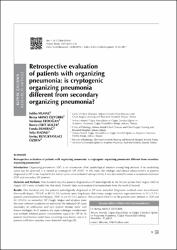Retrospective evaluation of patients with organizing pneumonia: is cryptogenic organizing pneumonia different from secondary organizing pneumonia?

View/
Access
info:eu-repo/semantics/openAccessDate
2017Author
Yilmaz, SalihaAkinci Ozyurek, Berna
Erdogan, Yurdanur
Cirit Kocer, Burcu
Demirag, Funda
Dadali, Yeliz
Buyukyaylaci Ozden, Sertac
Metadata
Show full item recordAbstract
Introduction: Organizing pneumonia (OP) is an uncommon clinic opathological situation among lung diseases. If no underlying cause can be detected, it is named as cryptogenic OP (COP). In this study, the etiologic and clinical characteristics of patients diagnosed as OP in our hospital in the last ten years were evaluated retrospectively. It was also aimed to make a comparison between COP and secondary OP patients. Materials and Methods: One hundred sixty-five patients diagnosed as OP pathologically in the 10 year period from August 2003 to August 2013 were included into that study. Patients' data were evaluated retrospectively from the medical records. Results: One hundred sixty five patients pathologically diagnosed as OP were included. Diagnostic methods were trans-thoracic fine-needle biopsy (TTFNB) in 89 (53.9%) patients, open lung biopsy (lobectomy, wedge resection, segmentectomy) in 52 (31.5%) patients and transbronchial biyopsy (TBB) in 24 (14.5%) patients. One hundred (60.6%) of the patients were defined as COP and 65 (39.4%) as secondary OP. Cough, fatigue and dyspnea were the most common symptoms on admission. We detected OP cases secondary to anthracosis and cyst hydatic besides other well known etiologies. In 61 patients, the main radiologic manifestation was multiple bilateral patchy consolidation typical for OP. In 76 patients focal lesions (solid mass, cavitating mass lesion) and in 6 patients infiltrative opacities were detected radiologically. Conclusion: There is no difference between properties of OP from clinical, laboratory and radiologic finding sin the criptogenic and seconder form of OP. Although it is not asserted, cyst hidatic and anthracosis could be kept in mind for the list of underlying ethiologies for secondary OP.
Source
TUBERKULOZ VE TORAK-TUBERCULOSIS AND THORAXVolume
65Issue
1Collections
Related items
Showing items related by title, author, creator and subject.
-
Computed tomography findings of organizing pneumonia
Dadali, Yeliz; Özkaçmaz, Sercan; Erdoğan, Yurdanur; Ünlü, Havva Akmaz; Demirağ, Funda; Bursalı, İlke (Kuwait Medical Association, 2022)Objective: In this study, we aimed to present computed tomography (CT) findings of 100 patients with histopathologically confirmed organizing pneumonia. Design: Retrospective study Setting: Ankara Atatürk Chest Diseases ... -
The Epidemiology of Carbapenemases in Escherichia Coli and Klebsiella Pneumoniae İsolated in 2019 in Turkey [Türkiye'de 2019 Yili Içinde Izole Edilen Escherichia coli ve Klebsiella pneumoniae Izolatlarinda Karbapenemaz Epidemiyolojisi]
Süzük Yıldız, Serap; Şimşek, Hüsniye; Bakkaloǧlu, Zekiye; ...; Sezgin, Fikriye Milletli; Karahan, Zeynep Ceren; Duman, Yücel (Ankara Microbiology Society, 2021)Antibiotic resistance is one of the most important public health problem and one of the most critical steps in preventing resistance is the monitorization of the resistance. Local, regional and global monitoring enables ... -
Organize pnömonili olguların retrospektif değerlendirilmesi: Kriptojenik organize pnömoni sekonder organize pnömoniden farklı mıdır?
Yılmaz, Saliha; Özyürek Akıncı, Berna; Erdoğan, Yurdanur; Cirit Koçer, Burcu; Demirağ, Funda; Dadalı, Yeliz; Özden Büyükyaylacı, Sertaç (2017)Giriş: Organize pnömoni (OP) akciğer hastalıkları içerisinde nadir görülen klinik opatolojik bir durumdur. Gerçek insidansı ve prevalansı bilinmemektedir. Altta yatan hastalık ya da neden belli değilse kriptojenik organize ...

















